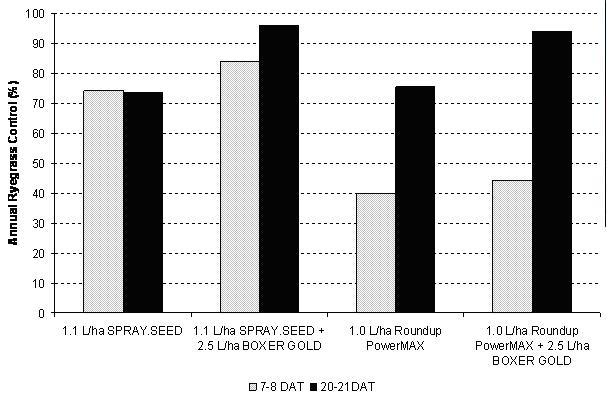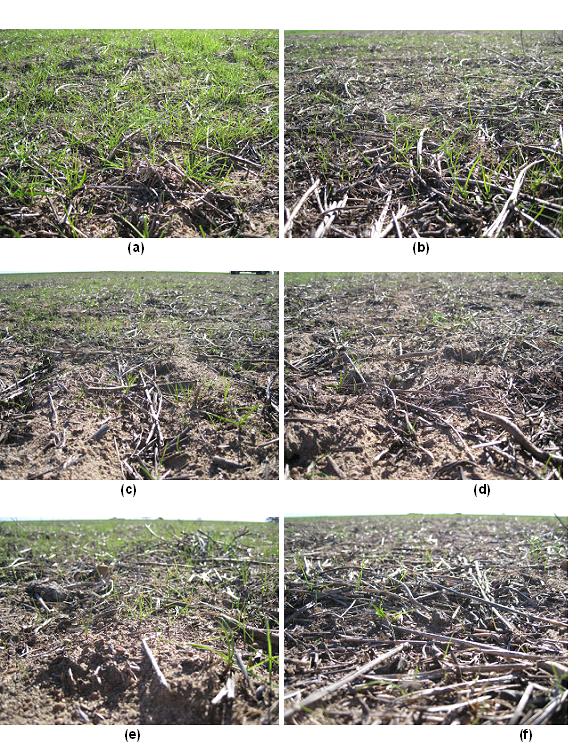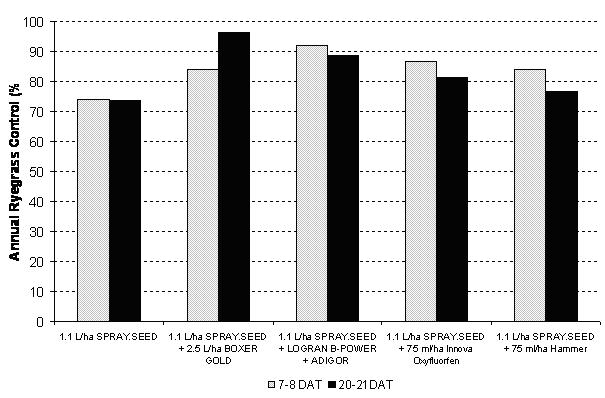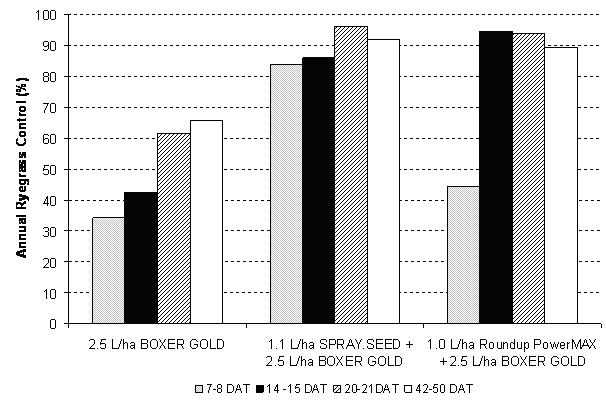Proven enhancemement in the knockdown control of seedling annual ryegrass (lolium rigidum gaudin) when using non-selective herbicides in tank mixtures with Boxer Gold
Proven enhancemement in the knockdown control of seedling annual ryegrass (lolium rigidum gaudin) when using non-selective herbicides in tank mixtures with Boxer Gold
| Date: 16 Sep 2009
One of these benefits relates to the three modes of uptake of the herbicide in susceptible weed species. Whilst the primary route of uptake of Boxer Gold is via the mesocotyl of emerging weed seeds, significant root and foliar uptake of the herbicide is also possible. The foliar uptake of Boxer Gold is well known and has been recently studied in relation to improvements in knockdown weed control when applied in tank mixtures with Spray.Seed® or glyphosate.
The foliar activity of Boxer Gold was evaluated in a number of replicated field trials across Southern Australia in 2007 and 2008, in particular targeting the control of seedling ARG plants at growth stage Z11 to Z12 (1 to 2 leaf stage). This series of trials assessed the efficacy of Boxer Gold alone, in tank mixtures with non-selective herbicides and in comparison with common Group G herbicide spikes#.
This research shows that Boxer Gold tended to improve the control of emerged 1 to 2 leaf ARG when used in tank mixtures with a registered rate of non-selective herbicides as per standard grower practice. Boxer Gold improved the control of 1 leaf to 3 leaf ARG by up to 16% over Spray.Seed or glyphosate alone. A comparison between Boxer Gold and common Group G herbicide spikes including carfentrazone-ethyl, oxyfluorfen and butafenacil (contained in Logran® B-Power®) also showed that Boxer Gold provided control of ARG at least equivalent to oxyfluorfen and Logran B-Power.
As some root uptake of Boxer Gold is also possible, movement of herbicide from the soil surface into the root zone of emerged seedling weeds is likely to enhance final weed kill. Sufficient rainfall within 7 days of application is therefore likely to enable maximum root uptake and final weed control. Similarly, the performance of Boxer Gold would be expected to be greater where mechanical incorporation of herbicide is practised as recommended on the product label for maximum residual weed control as well as providing a degree of mechanical weed kill.
In addition to providing excellent pre-emergent control of ARG the demonstrated improvement in knockdown control of seedling ARG provides reduced weed competition, greater water and nutrient use efficiency and improved crop establishment.
Key facts for enhanced knockdown control using Boxer Gold:
- New pre-emergent herbicide chemistry
- Alternative Mode Of Action for the management of herbicide resistant ARG
- Shoot, root and foliar uptake
- Enhanced knockdown weed control when targeting ARG (1 to 2 leaf) in mixtures with Spray.Seed or glyphosate
- Seedling ARG (1 to 2 leaf) control equivalent/superior to Group G herbicides
- Weed growth stage and rainfall within 7 days of application will influence final weed control
- Speed of weed kill dependent upon non-selective tank-mix partner
- Avoid heavy infestations of emerged weeds at application
- A registered rate of non-selective herbicide should always be used and the additional activity from Boxer Gold does not warrant a reduction in glyphosate or Spray.Seed rate
Aims
To determine if the foliar and root uptake of Boxer Gold may provide an enhancement in the knockdown control of seedling ARG when applied alone or in a tank mixture with various non-selective herbicide partners.
Methods
The foliar activity of Boxer Gold was evaluated in a number of Syngenta Crop Protection and independent trials conducted across Southern Australia in 2007 and 2008, in particular targeting the control of seedling ARG plants. This series of trials assessed the efficacy of Boxer Gold alone, in tank mixtures with non-selective herbicides and in comparison with common Group G herbicide spikes.
All herbicides were applied using a pressurised hand-boom delivering a water rate of 50-100 L/ha. Trials were set up in a RCBD as small plots and consisted of 3-4 replicates.
Herbicide treatments were applied to emerged ARG plants at growth stage Z11 to Z13 (1 to 3 leaf stage) under normal field conditions, with no mechanical incorporation of herbicide taking place. Initial weed density was established using a random sampling method and objective assessment of plant numbers within a 0.3 m2 quadrat, with 20 counts conducted across each site.
Efficacy of weed control was assessed through subjective assessment of weed brownout or plant death compared to control plots at 7, 14, 21 and 42 days after herbicide treatment. Photos of weed control were also taken in some trials.
Results
Boxer Gold tended to provide an improvement in the knockdown control of seedling ARG when used in a tank mixture with a registered rate of non-selective herbicide. Mixtures with Spray.Seed or glyphosate increased ARG control by up to 16% compared to either of the non-selective herbicides applied alone (Figures 1 & 2).

Figure 1: Knockdown activity of Boxer Gold in the control of Annual Ryegrass (Z11 to Z13) when applied in tank mixtures with Roundup PowerMAX* or Spray.Seed, Southern Australia 2008.
Data is mean of 4 replicated field trials conducted across Southern Australia from 2007-2008. Results 7-8 days after treatment (DAT) and 20-21 DAT. LSD (P < 0.05) = 29.8 (7-8 DAT) and 29.6 (20-21 DAT). Source: Syngenta Crop Protection and Landmark Product Development.
A comparison between Boxer Gold and common Group G herbicide spikes such as carfentrazone-ethyl, oxyfluorfen (Innova Oxyfluorfen 240EC) and butafenacil (contained in Logran B-Power) also showed that Boxer Gold provided control of ARG at least equivalent to oxyfluorfen and Logran B-Power and tended to provide greater control than carfentrazone-ethyl (Figure 3). Further work is required to evaluate performance in the control of broadleaf weed species.

Figure 2: Knockdown activity of Boxer Gold in the control of Annual Ryegrass (Z11 to Z13) when applied in tank mixtures with glyphosate or Spray.Seed, Grass Valley WA 2008.
(a) Untreated, (b) Boxer Gold 2.5 L/ha, (c) Roundup PowerMax 1.0 L/ha, (d) Roundup PowerMAX 1.0 L/ha + Boxer Gold 2.5 L/ha, (e) Spray.Seed 1.1 L/ha and (f) Spray.Seed 1.1 L/ha + Boxer Gold 2.5 L/ha.
Photos taken 19 days after application. Source: Courtesy of Craig Ruchs, Syngenta Crop Protection.
This series of trials evaluated knockdown weed control only and did not involve mechanical disturbance following herbicide application. The performance of Boxer Gold would be expected to be greater where mechanical incorporation of herbicide is practised as recommended on the product label for maximum residual weed control as well as providing a degree of mechanical weed kill.

Figure 3: Comparison of Boxer Gold versus common Group G knockdown spikes in the control of Annual Ryegrass (Z11 to Z13), Southern Australia 2008.
Data is mean of 4 replicated field trials conducted across Southern Australia from 2007-2008. Results 7-8 days after treatment (DAT) and 20-21 DAT. LSD (P < 0.05) = 29.8 (7-8 DAT) and 29.6 (20-21 DAT). Source: Syngenta Crop Protection and Landmark Product Development.
Factors that maximise product performance
The level of additional knockdown weed control achieved using Boxer Gold is likely to be influenced by two key factors;
(a) Weed growth stage - Target 1 leaf to 2 leaf ARG:
Current research suggest that the foliar activity of Boxer Gold on ARG is greatest on 1 leaf to 2 leaf plants and the efficacy of the herbicide in enhancing knockdown control of weeds beyond this growth stage at application is likely to be significantly reduced.
(b) Rainfall within 7 days of application is likely to maximise herbicide performance:
As some root uptake of Boxer Gold is also possible, movement of herbicide from the soil surface into the root zone of emerged seedling weeds is likely to greatly enhance final weed kill. Sufficient rainfall within 7 days of application will enable maximum root uptake and final weed control.
Herbicide symptoms and speed of activity
The characteristic symptoms resulting from foliar application of Boxer Gold on seedling ARG are leaf twisting and distortion, often in combination with plants turning a darker green in colour. Typically, symptoms are slow to develop. Time until complete plant death is dependent on the chosen non-selective herbicide partner and is fastest when used with Spray.Seed (Figure 4).
As the rainfast requirement for Boxer Gold is short, this makes tank mixtures with Spray.Seed ideally suited for knockdown weed control of seedling grass and broadleaf weeds. Whilst rainfall within 1 hour of application of Boxer Gold may reduce foliar uptake, subsequent root uptake and final weed control is likely to be improved. Most Spray.Seed is absorbed within 10 minutes and is considered rainfast within 30 minutes of application. A tank mixture of Boxer Gold and Spray.Seed is a very effective combination, offering security in uncertain weather conditions.
Effect on residual weed control
Similar to all other soil applied herbicides, the presence of an existing weed infestation prior to planting has the potential to reduce residual weed control through uptake or adsorption of active ingredient by/to plant foliage as well as preventing active ingredient from reaching the soil surface. As such, it is recommended to avoid applying any pre-emergent herbicide in situations where significant plant biomass is present as existing weed cover.

Figure 4: Speed of activity using Boxer Gold in tank mixtures with Spray.Seed or glyphosate for the control of Annual Ryegrass (Z11to Z13), Southern Australia 2008. Data is mean of 4 replicated field trials conducted across Southern Australia from 2007-2008.
Results 7-8 days after treatment (DAT), 14-15 DAT, 20-21 DAT and 42-50 DAT. LSD (P < 0.05) = 29.8 (7-8 DAT), 24.5 (14-15 DAT), 29.6 (20-21 DAT) and 21.8 (42-50 DAT). Source: Syngenta Crop Protection and Landmark Product Development.
Conclusions
This research demonstrates the ability of Boxer Gold to improve the control of emerged 1 to 2 leaf ARG when used in tank mixtures with a registered rate of non-selective herbicides as per standard grower practice. Having alternate MOA, this herbicide may be used as part of an integrated weed management strategy for the management of herbicide resistant ARG biotypes. The wider window for incorporation (7 days), rotational flexibility and compatibility of Boxer Gold with a range of knockdown herbicide and insecticide tank mix partners further adds to the flexibility of this herbicide relative to current pre-emergent alternatives.
In addition to providing excellent pre-emergent control of annual ryegrass, the demonstrated improvement in knockdown control of seedling ARG reduces early weed competition and provides greater water and nutrient use efficiency and improved crop establishment.
Acknowledgements
The author would like to acknowledge the Landmark Product Development group for contribution of some of the replicated data presented and J. Sabeeney for peer review of this paper.
Paper reviewed by:
Jason Sabeeney
#This information does not endorse the use of Boxer Gold post crop emergence nor does it support the use of Boxer Gold as a direct substitute for a non-selective herbicide.
® Registered trademarks of a Syngenta Group Company. * Registered trademark.
Was this page helpful?
YOUR FEEDBACK
